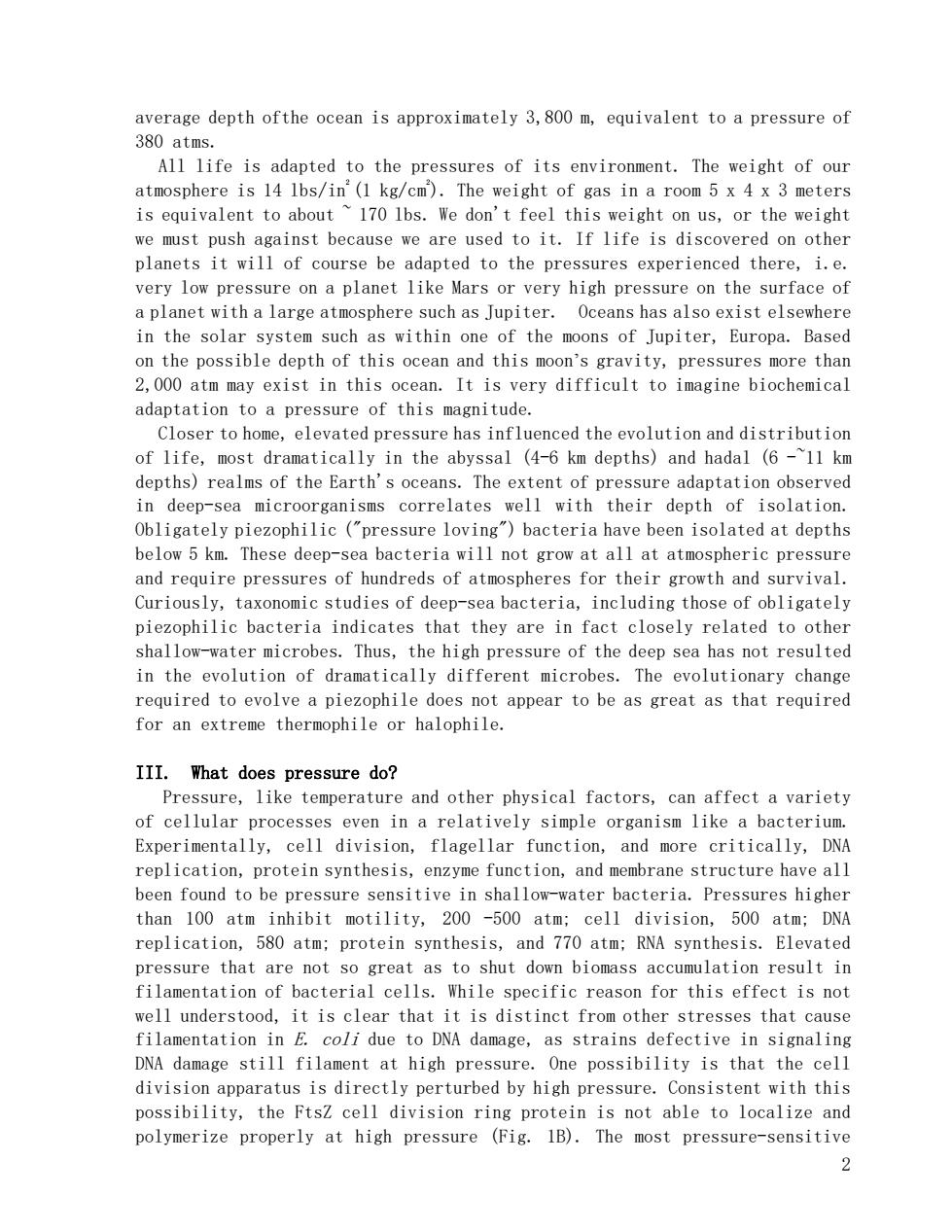正在加载图片...

average depth ofthe ocean is approximately 3,800 m,equivalent to a pressure of 380 atms. All life is adapted to the pressures of its environment.The weight of our atmosphere is 14 lbs/in'(1 kg/cm).The weight of gas in a room 5 x 4 x 3 meters is equivalent to about 170 lbs.We don't feel this weight on us,or the weight we must push against because we are used to it.If life is discovered on other planets it will of course be adapted to the pressures experienced there,i.e. very low pressure on a planet like Mars or very high pressure on the surface of a planet with a large atmosphere such as Jupiter.Oceans has also exist elsewhere in the solar system such as within one of the moons of Jupiter,Europa.Based on the possible depth of this ocean and this moon's gravity,pressures more than 2,000 atm may exist in this ocean.It is very difficult to imagine biochemical adaptation to a pressure of this magnitude. Closer to home,elevated pressure has influenced the evolution and distribution of life,most dramatically in the abyssal (4-6 km depths)and hadal (6-11 km depths)realms of the Earth's oceans.The extent of pressure adaptation observed in deep-sea microorganisms correlates well with their depth of isolation. Obligately piezophilic ("pressure loving)bacteria have been isolated at depths below 5 km.These deep-sea bacteria will not grow at all at atmospheric pressure and require pressures of hundreds of atmospheres for their growth and survival. Curiously,taxonomic studies of deep-sea bacteria,including those of obligately piezophilic bacteria indicates that they are in fact closely related to other shallow-water microbes.Thus,the high pressure of the deep sea has not resulted in the evolution of dramatically different microbes.The evolutionary change required to evolve a piezophile does not appear to be as great as that required for an extreme thermophile or halophile. III.What does pressure do? Pressure,like temperature and other physical factors,can affect a variety of cellular processes even in a relatively simple organism like a bacterium. Experimentally,cell division,flagellar function,and more critically,DNA replication,protein synthesis,enzyme function,and membrane structure have all been found to be pressure sensitive in shallow-water bacteria.Pressures higher than 100 atm inhibit motility,200 -500 atm;cell division,500 atm;DNA replication,580 atm;protein synthesis,and 770 atm;RNA synthesis.Elevated pressure that are not so great as to shut down biomass accumulation result in filamentation of bacterial cells.While specific reason for this effect is not well understood,it is clear that it is distinct from other stresses that cause filamentation in E.coli due to DNA damage,as strains defective in signaling DNA damage still filament at high pressure.One possibility is that the cell division apparatus is directly perturbed by high pressure.Consistent with this possibility,the FtsZ cell division ring protein is not able to localize and polymerize properly at high pressure (Fig.IB).The most pressure-sensitive 22 average depth ofthe ocean is approximately 3,800 m, equivalent to a pressure of 380 atms. All life is adapted to the pressures of its environment. The weight of our atmosphere is 14 lbs/in 2 (1 kg/cm 2). The weight of gas in a room 5 x 4 x 3 meters is equivalent to about ~ 170 lbs. We don't feel this weight on us, or the weight we must push against because we are used to it. If life is discovered on other planets it will of course be adapted to the pressures experienced there, i.e. very low pressure on a planet like Mars or very high pressure on the surface of a planet with a large atmosphere such as Jupiter. Oceans has also exist elsewhere in the solar system such as within one of the moons of Jupiter, Europa. Based on the possible depth of this ocean and this moon’s gravity, pressures more than 2,000 atm may exist in this ocean. It is very difficult to imagine biochemical adaptation to a pressure of this magnitude. Closer to home, elevated pressure has influenced the evolution and distribution of life, most dramatically in the abyssal (4-6 km depths) and hadal (6 -~11 km depths) realms of the Earth's oceans. The extent of pressure adaptation observed in deep-sea microorganisms correlates well with their depth of isolation. Obligately piezophilic ("pressure loving") bacteria have been isolated at depths below 5 km. These deep-sea bacteria will not grow at all at atmospheric pressure and require pressures of hundreds of atmospheres for their growth and survival. Curiously, taxonomic studies of deep-sea bacteria, including those of obligately piezophilic bacteria indicates that they are in fact closely related to other shallow-water microbes. Thus, the high pressure of the deep sea has not resulted in the evolution of dramatically different microbes. The evolutionary change required to evolve a piezophile does not appear to be as great as that required for an extreme thermophile or halophile. III. What does pressure do? Pressure, like temperature and other physical factors, can affect a variety of cellular processes even in a relatively simple organism like a bacterium. Experimentally, cell division, flagellar function, and more critically, DNA replication, protein synthesis, enzyme function, and membrane structure have all been found to be pressure sensitive in shallow-water bacteria. Pressures higher than 100 atm inhibit motility, 200 -500 atm; cell division, 500 atm; DNA replication, 580 atm; protein synthesis, and 770 atm; RNA synthesis. Elevated pressure that are not so great as to shut down biomass accumulation result in filamentation of bacterial cells. While specific reason for this effect is not well understood, it is clear that it is distinct from other stresses that cause filamentation in E. coli due to DNA damage, as strains defective in signaling DNA damage still filament at high pressure. One possibility is that the cell division apparatus is directly perturbed by high pressure. Consistent with this possibility, the FtsZ cell division ring protein is not able to localize and polymerize properly at high pressure (Fig. 1B). The most pressure-sensitive